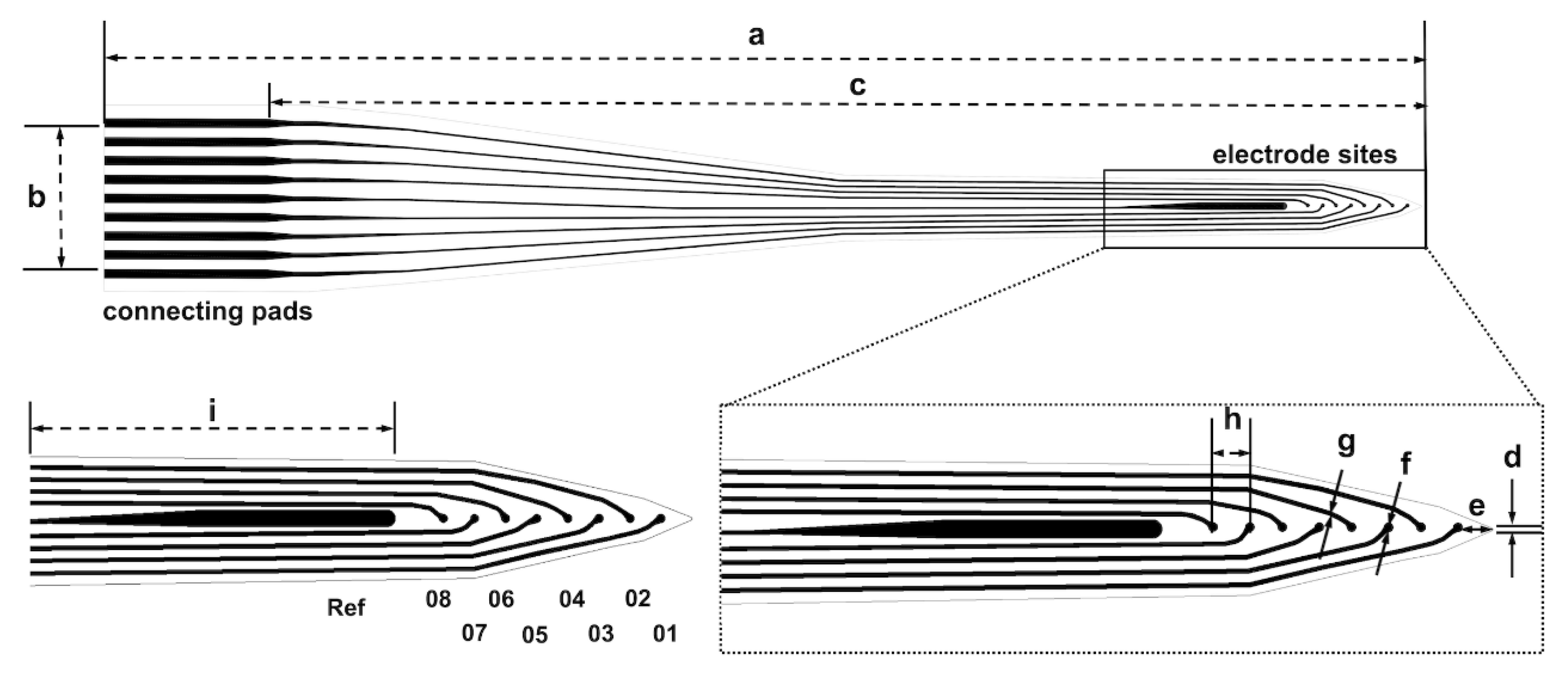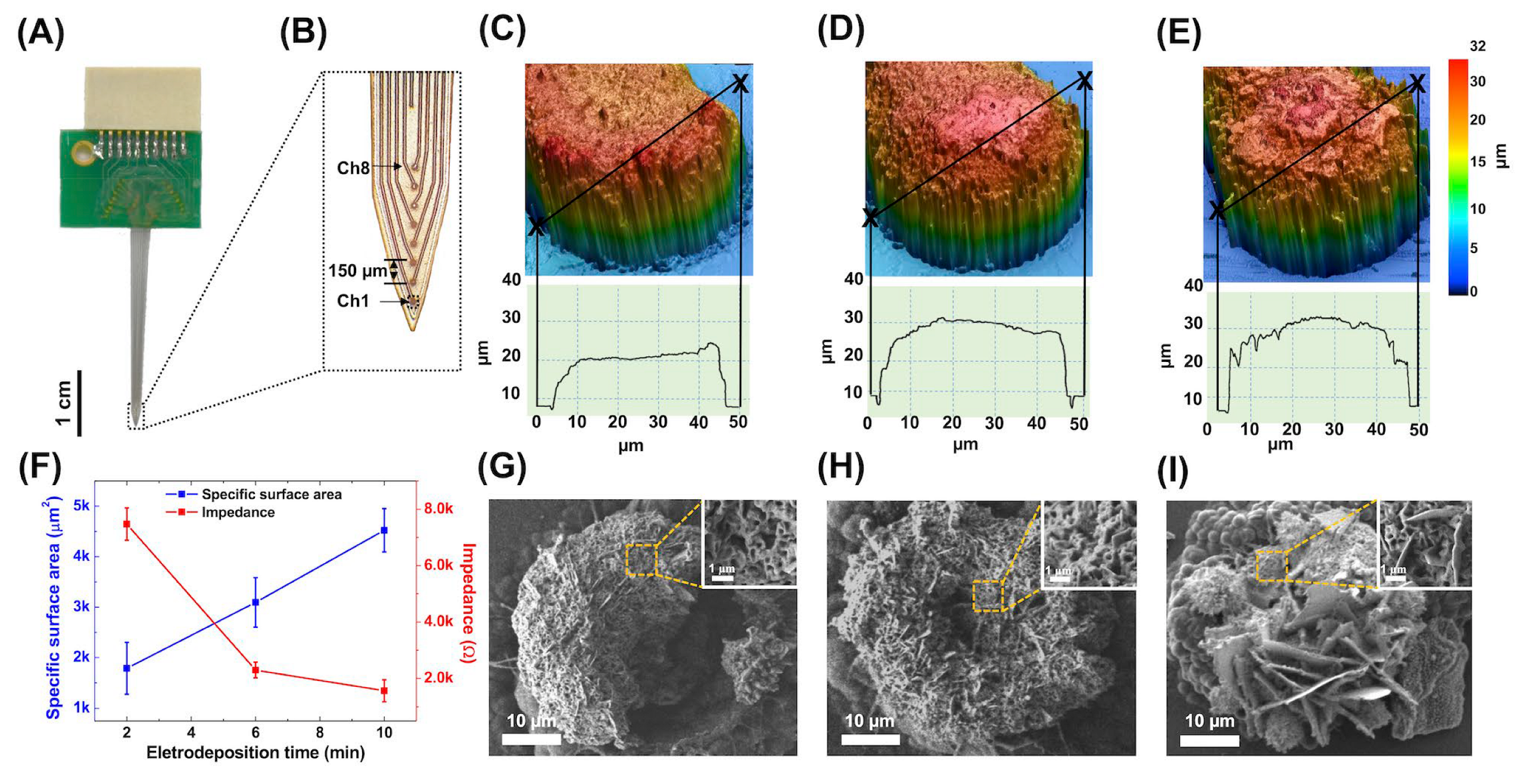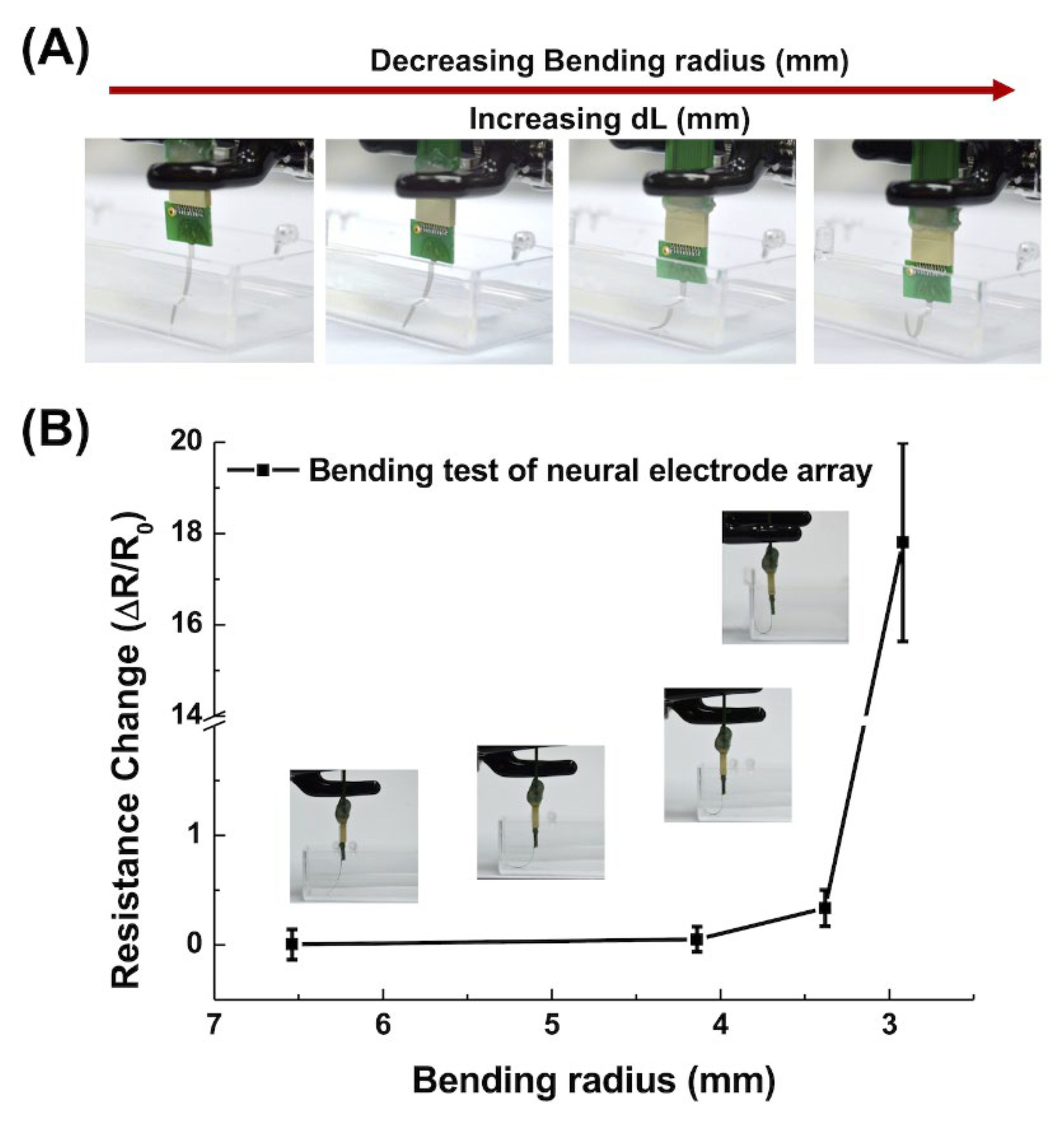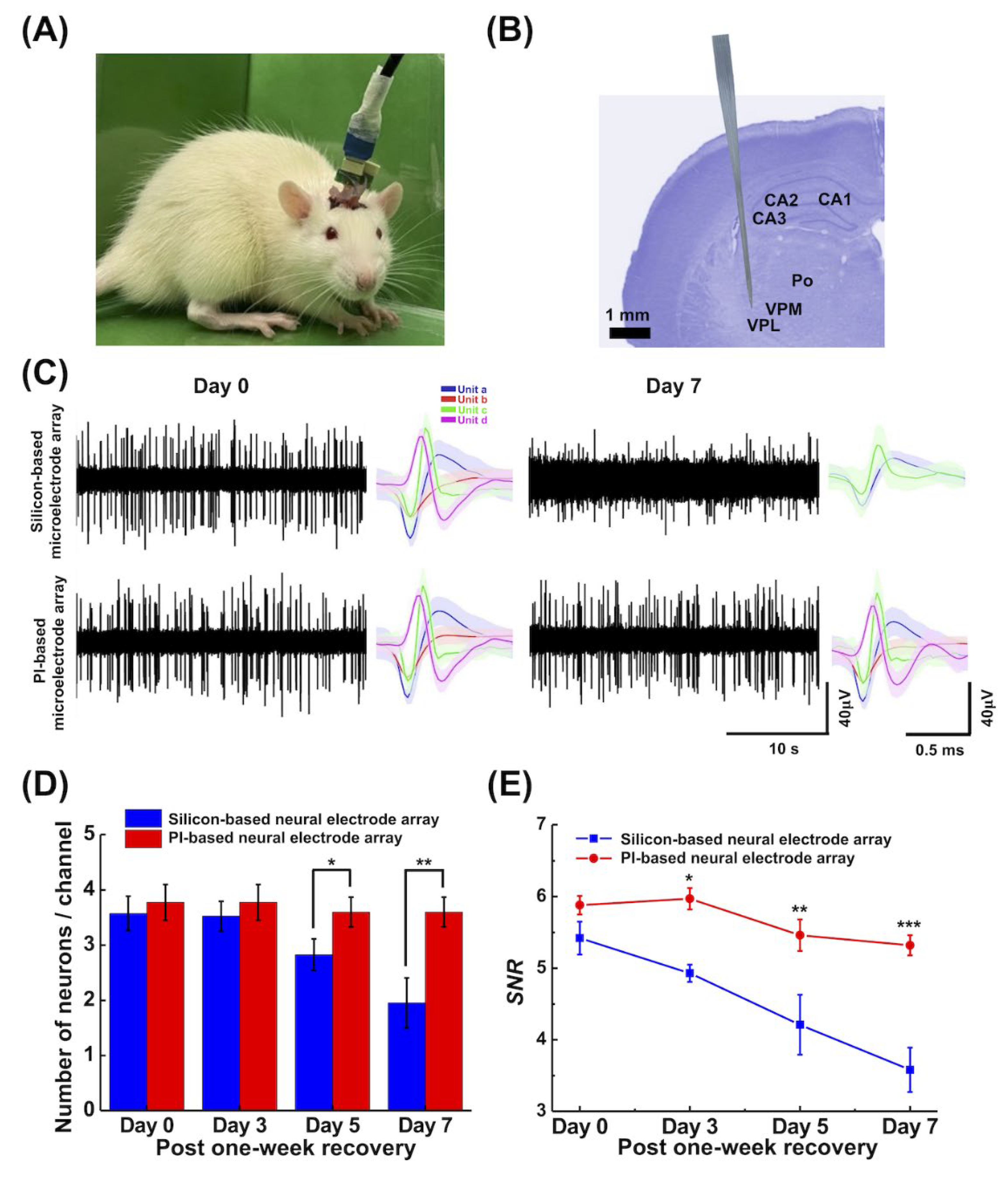Proof of Concept for Sustainable Manufacturing of Neural Electrode Array for In Vivo Recording
Abstract
1. Introduction
2. Materials and Methods
2.1. Design and Fabrication of a Neural Electrode Array
2.2. Characterization of Neural Electrode Array
2.3. Bending Test
2.4. In Vivo Implantation of the Neural Electrode Array
2.4.1. Animal Preparation and Neural Implantation Surgery (N = 5)
2.4.2. Neural Recording and Analysis
2.5. Immunohistochemistry
2.6. Analysis of Carbon Footprint
3. Results
3.1. Fabless Manufacturing of a Flexible Neural Electrode Array
3.2. Bending Challenge
3.3. In Vivo Electrophysiological Signal Recording
3.4. Immunohistochemistry
3.5. Carbon Footprint
4. Discussion
4.1. Electrochemically Modified Electrodes with Gold Nanostructure and Influence for the Surface Area
4.2. Electric Performance of the Neural Electrode Array under Bending Condition
4.3. Long-Term Implantation with Stable Neural Recording and Biocompatibility
4.4. Evaluation the Carbon Footprint of Manufacturing Process of for Neural Electrode Array
5. Conclusions
Author Contributions
Funding
Institutional Review Board Statement
Informed Consent Statement
Data Availability Statement
Conflicts of Interest
References
- Kook, G.; Lee, S.W.; Lee, H.C.; Cho, I.-J.; Lee, H.J. Neural Probes for Chronic Applications. Micromachines 2016, 7, 179. [Google Scholar] [CrossRef] [PubMed]
- Beygi, M.; Bentley, J.T.; Frewin, C.L.; Kuliasha, C.A.; Takshi, A.; Bernardin, E.K.; La Via, F.; Saddow, S.E. Fabrication of a Monolithic Implantable Neural Interface from Cubic Silicon Carbide. Micromachines 2019, 10, 430. [Google Scholar] [CrossRef] [PubMed]
- Lee, J.; Parker, K.E.; Kawakami, C.; Kim, J.R.; Qazi, R.; Yea, J.; Zhang, S.; Kim, C.Y.; Bilbily, J.; Xiao, J. Rapidly Customizable, Scalable 3D-Printed Wireless Optogenetic Probes for Versatile Applications in Neuroscience. Adv. Funct. Mater. 2020, 30, 2004285. [Google Scholar] [CrossRef] [PubMed]
- Lee, H.J.; Son, Y.; Kim, J.; Lee, C.J.; Yoon, E.-S.; Cho, I.-J. A Multichannel Neural Probe with Embedded Microfluidic Channels for Simultaneous in vivo Neural Recording and Drug Delivery. Lab A Chip 2015, 15, 1590–1597. [Google Scholar] [CrossRef]
- Zhao, Z.; Gong, R.; Huang, H.; Wang, J. Design, Fabrication, Simulation and Characterization of a Novel Dual-sided Microelectrode Array for Deep Brain Recording and Stimulation. Sensors 2016, 16, 880. [Google Scholar] [CrossRef]
- Matsumoto, R.; Kunieda, T.; Nair, D. Single Pulse Electrical Stimulation to Probe Functional and Pathological Connectivity in Epilepsy. Seizure 2017, 44, 27–36. [Google Scholar] [CrossRef]
- Tóth, E.; Fabó, D.; Entz, L.; Ulbert, I.; Erőss, L. Intracranial Neuronal Ensemble Recordings and Analysis in Epilepsy. J. Neurosci. Methods 2016, 260, 261–269. [Google Scholar] [CrossRef]
- HajjHassan, M.; Chodavarapu, V.; Musallam, S. NeuroMEMS: Neural Probe Microtechnologies. Sensors 2008, 8, 6704–6726. [Google Scholar] [CrossRef]
- Pothof, F.; Bonini, L.; Lanzilotto, M.; Livi, A.; Fogassi, L.; Orban, G.A.; Paul, O.; Ruther, P. Chronic Neural Probe for Simultaneous Recording of Single-unit, Multi-unit, and Local Field Potential Activity from Multiple Brain Sites. J. Neural Eng. 2016, 13, 046006. [Google Scholar] [CrossRef]
- Jun, J.J.; Steinmetz, N.A.; Siegle, J.H.; Denman, D.J.; Bauza, M.; Barbarits, B.; Lee, A.K.; Anastassiou, C.A.; Andrei, A.; Aydın, Ç. Fully Integrated Silicon Probes for High-density Recording of Neural Activity. Nature 2017, 551, 232–236. [Google Scholar] [CrossRef]
- Reddy, J.W.; Kimukin, I.; Stewart, L.T.; Ahmed, Z.; Barth, A.L.; Towe, E.; Chamanzar, M. High Density, Double-sided, Flexible Optoelectronic Neural Probes with Embedded μLEDs. Front. Neurosci. 2019, 13, 745. [Google Scholar] [CrossRef]
- Wu, F.; Stark, E.; Ku, P.-C.; Wise, K.D.; Buzsáki, G.; Yoon, E. Monolithically Integrated μLEDs on Silicon Neural Probes for High-resolution Optogenetic Studies in Behaving Animals. Neuron 2015, 88, 1136–1148. [Google Scholar] [CrossRef]
- Shin, H.; Byun, J.; Roh, D.; Choi, N.; Shin, H.-S.; Cho, I.-J. Interference-free, Lightweight Wireless Neural Probe System for Investigating Brain Activity during Natural Competition. Biosens. Bioelectron. 2022, 195, 113665. [Google Scholar] [CrossRef]
- Hong, G.; Lieber, C.M. Novel Electrode Technologies for Neural Recordings. Nat. Rev. Neurosci. 2019, 20, 330–345. [Google Scholar] [CrossRef]
- Raducanu, B.C.; Yazicioglu, R.F.; Lopez, C.M.; Ballini, M.; Putzeys, J.; Wang, S.; Andrei, A.; Rochus, V.; Welkenhuysen, M.; Van Helleputte, N. Time Multiplexed Active Neural Probe with 1356 Parallel Recording Sites. Sensors 2017, 17, 2388. [Google Scholar] [CrossRef]
- Schäffer, L.; Nagy, Z.; Kincses, Z.; Fiáth, R.; Ulbert, I. Spatial Information Based OSort for Real-time Spike Sorting using FPGA. IEEE Trans. Biomed. Eng. 2020, 68, 99–108. [Google Scholar] [CrossRef]
- Bennett, C.; Gale, S.D.; Garrett, M.E.; Newton, M.L.; Callaway, E.M.; Murphy, G.J.; Olsen, S.R. Higher-order Thalamic Circuits Channel Parallel Streams of Visual Information in Mice. Neuron 2019, 102, 477–492.e5. [Google Scholar] [CrossRef]
- Stringer, C.; Pachitariu, M.; Steinmetz, N.; Carandini, M.; Harris, K.D. High-dimensional Geometry of Population Responses in Visual Cortex. Nature 2019, 571, 361–365. [Google Scholar] [CrossRef]
- Vélez-Fort, M.; Bracey, E.F.; Keshavarzi, S.; Rousseau, C.V.; Cossell, L.; Lenzi, S.C.; Strom, M.; Margrie, T.W. A Circuit for Integration of Head-and Visual-motion Signals in Layer 6 of Mouse Primary Visual Cortex. Neuron 2018, 98, 179–191.e6. [Google Scholar] [CrossRef]
- Gardner, R.J.; Lu, L.; Wernle, T.; Moser, M.-B.; Moser, E.I. Correlation Structure of Grid Cells is Preserved during Sleep. Nat. Neurosci. 2019, 22, 598–608. [Google Scholar] [CrossRef]
- Luo, T.Z.; Bondy, A.G.; Gupta, D.; Elliott, V.A.; Kopec, C.D.; Brody, C.D. An Approach for Long-term, Multi-probe Neuropixels Recordings in Unrestrained Rats. eLife 2020, 9, e59716. [Google Scholar] [CrossRef] [PubMed]
- Trautmann, E.M.; Stavisky, S.D.; Lahiri, S.; Ames, K.C.; Kaufman, M.T.; O’Shea, D.J.; Vyas, S.; Sun, X.; Ryu, S.I.; Ganguli, S. Accurate Estimation of Neural Population Dynamics without Spike Sorting. Neuron 2019, 103, 292–308.e4. [Google Scholar] [CrossRef] [PubMed]
- Thelin, J.; Jörntell, H.; Psouni, E.; Garwicz, M.; Schouenborg, J.; Danielsen, N.; Linsmeier, C.E. Implant Size and Fixation Mode Strongly Influence Tissue Reactions in the CNS. PLoS ONE 2011, 6, e16267. [Google Scholar] [CrossRef] [PubMed]
- Chandrasekaran, S.; Fifer, M.; Bickel, S.; Osborn, L.; Herrero, J.; Christie, B.; Xu, J.; Murphy, R.K.; Singh, S.; Glasser, M.F. Historical Perspectives, Challenges, and Future Directions of Implantable Brain-computer Interfaces for Sensorimotor Applications. Bioelectron. Med. 2021, 7, 14. [Google Scholar] [CrossRef] [PubMed]
- Juavinett, A.L.; Bekheet, G.; Churchland, A.K. Chronically Implanted Neuropixels Probes Enable High-yield Recordings in Freely Moving Mice. eLife 2019, 8, e47188. [Google Scholar] [CrossRef]
- Steinmetz, N.A.; Aydin, C.; Lebedeva, A.; Okun, M.; Pachitariu, M.; Bauza, M.; Beau, M.; Bhagat, J.; Böhm, C.; Broux, M. Neuropixels 2.0: A Miniaturized High-density Probe for Stable, Long-term Brain Recordings. Science 2021, 372, eabf4588. [Google Scholar] [CrossRef]
- Mullen, E.; Morris, M.A. Green Nanofabrication Opportunities in the Semiconductor Industry: A Life Cycle Perspective. Nanomaterials 2021, 11, 1085. [Google Scholar] [CrossRef]
- Villard, A.; Lelah, A.; Brissaud, D. Drawing a Chip Environmental Profile: Environmental Indicators for the Semiconductor Industry. J. Clean. Prod. 2015, 86, 98–109. [Google Scholar] [CrossRef]
- Polanco, M.; Yoon, H.; Bawab, S. Micromotion-induced Dynamic Effects from a Neural Probe and Brain Tissue Interface. J. Micro/Nanolithography MEMS MOEMS 2014, 13, 023009. [Google Scholar] [CrossRef]
- Richardson Jr, R.; Miller, J.; Reichert, W.M. Polyimides as Biomaterials: Preliminary Biocompatibility Testing. Biomaterials 1993, 14, 627–635. [Google Scholar] [CrossRef]
- Huang, W.C.; Lai, H.Y.; Kuo, L.W.; Liao, C.H.; Chang, P.H.; Liu, T.C.; Chen, S.Y.; Chen, Y.Y. Multifunctional 3D Patternable Drug-Embedded Nanocarrier-Based Interfaces to Enhance Signal Recording and Reduce Neuron Degeneration in Neural Implantation. Adv. Mater. 2015, 27, 4186–4193. [Google Scholar] [CrossRef]
- Huang, W.C.; Lo, Y.C.; Chu, C.Y.; Lai, H.Y.; Chen, Y.Y.; Chen, S.Y. Conductive nanogel-interfaced neural microelectrode arrays with electrically controlled in-situ delivery of manganese ions enabling high-resolution MEMRI for synchronous neural tracing with deep brain stimulation. Biomaterials 2017, 122, 141–153. [Google Scholar] [CrossRef]
- Lacour, S.P.; Courtine, G.; Guck, J. Materials and Technologies for Soft Implantable Neuroprostheses. Nat. Rev. Mater. 2016, 1, 16063. [Google Scholar] [CrossRef]
- Li, S.J.; Lo, Y.C.; Lai, H.Y.; Lin, S.H.; Lin, H.C.; Lin, T.C.; Chang, C.W.; Chen, T.C.; Chin-Jung Hsieh, C.; Yang, S.H.; et al. Uncovering the Modulatory Interactions of Brain Networks in Cognition with Central Thalamic Deep Brain Stimulation Using Functional Magnetic Resonance Imaging. Neuroscience 2020, 440, 65–84. [Google Scholar] [CrossRef]
- Lin, T.C.; Lo, Y.C.; Lin, H.C.; Li, S.J.; Lin, S.H.; Wu, H.F.; Chu, M.C.; Lee, C.W.; Lin, I.C.; Chang, C.W.; et al. MR imaging central thalamic deep brain stimulation restored autistic-like social deficits in the rat. Brain Stimul. 2019, 12, 1410–1420. [Google Scholar] [CrossRef]
- Liu, T.C.; Chuang, M.C.; Chu, C.Y.; Huang, W.C.; Lai, H.Y.; Wang, C.T.; Chu, W.L.; Chen, S.Y.; Chen, Y.Y. Implantable Graphene-based Neural Electrode Interfaces for Electrophysiology and Neurochemistry in In Vivo Hyperacute Stroke Model. ACS Appl. Mater. Interfaces 2016, 8, 187–196. [Google Scholar] [CrossRef]
- Nguyen, J.K.; Park, D.J.; Skousen, J.L.; Hess-Dunning, A.E.; Tyler, D.J.; Rowan, S.J.; Weder, C.; Capadona, J.R. Mechanically-compliant intracortical implants reduce the neuroinflammatory response. J. Neural Eng. 2014, 11, 056014. [Google Scholar] [CrossRef]
- Zhang, S.; Wang, C.; Gao, H.; Yu, C.; Yan, Q.; Lu, Y.; Tao, Z.; Linghu, C.; Chen, Z.; Xu, K. A Removable Insertion Shuttle for Ultraflexible Neural Probe Implantation with Stable Chronic Brain Electrophysiological Recording. Adv. Mater. Interfaces 2020, 7, 1901775. [Google Scholar] [CrossRef]
- Sim, J.Y.; Haney, M.P.; Park, S.I.; McCall, J.G.; Jeong, J.-W. Microfluidic Neural Probes: In vivo Tools for Advancing Neuroscience. Lab A Chip 2017, 17, 1406–1435. [Google Scholar] [CrossRef]
- Rousche, P.J.; Pellinen, D.S.; Pivin, D.P.; Williams, J.C.; Vetter, R.J.; Kipke, D.R. Flexible Polyimide-based Intracortical Electrode Arrays with Bioactive Capability. IEEE Trans. Biomed. Eng. 2001, 48, 361–371. [Google Scholar] [CrossRef]
- Yuk, H.; Lu, B.; Lin, S.; Qu, K.; Xu, J.; Luo, J.; Zhao, X. 3D Printing of Conducting Polymers. Nat. Commun. 2020, 11, 1604. [Google Scholar] [CrossRef]
- Jiang, Z.; Li, L.; Huang, H.; He, W.; Ming, W. Progress in Laser Ablation and Biological Synthesis Processes:“Top-Down” and “Bottom-Up” Approaches for the Green Synthesis of Au/Ag Nanoparticles. Int. J. Mol. Sci. 2022, 23, 14658. [Google Scholar] [CrossRef]
- Gonçalves, F.A.; Fonseca, A.; Domingos, M.; Gloria, A.; Serra, A.; Coelho, J.F. The Potential of Unsaturated Polyesters in Biomedicine and Tissue Engineering: Synthesis, Structure-properties Relationships and Additive Manufacturing. Prog. Polym. Sci. 2017, 68, 1–34. [Google Scholar] [CrossRef]
- Li, L.; Hong, M.; Schmidt, M.; Zhong, M.; Malshe, A.; Huis, B.; Kovalenko, V. Laser Nano-manufacturing–state of the Art and Challenges. CIRP Ann. 2011, 60, 735–755. [Google Scholar] [CrossRef]
- Schuettler, M.; Stiess, S.; King, B.; Suaning, G. Fabrication of Implantable Microelectrode Arrays by Laser Cutting of Silicone Rubber and Platinum Foil. J. Neural Eng. 2005, 2, S121. [Google Scholar] [CrossRef] [PubMed]
- Bai, J.G.; Zhang, Z.Z.; Calata, J.N.; Lu, G.-Q. Low-temperature Sintered Nanoscale Silver as a Novel Semiconductor Device-Metallized Substrate Interconnect Material. IEEE Trans. Compon. Packag. Technol. 2006, 29, 589–593. [Google Scholar] [CrossRef]
- Wang, T.; Chen, X.; Lu, G.-Q.; Lei, G.-Y. Low-temperature Sintering with Nano-silver Paste in Die-attached Interconnection. J. Electron. Mater. 2007, 36, 1333–1340. [Google Scholar] [CrossRef]
- O’Shaughnessy, W.; Edell, D.; Gleason, K. Initiated Chemical Vapor Deposition of a Siloxane Coating for Insulation of Neural Probes. Thin Solid Film. 2009, 517, 3612–3614. [Google Scholar] [CrossRef]
- Park, S.I.; Ahn, J.H.; Feng, X.; Wang, S.; Huang, Y.; Rogers, J.A. Theoretical and Experimental Studies of Bending of Inorganic Electronic Materials on Plastic Substrates. Adv. Funct. Mater. 2008, 18, 2673–2684. [Google Scholar] [CrossRef]
- Chen, Y.-Y.; Kuo, T.-S.; Jaw, F.-S. A Laser Micromachined Probe for Recording Multiple Field Potentials in the Thalamus. J. Neurosci. Methods 2004, 139, 99–109. [Google Scholar] [CrossRef]
- Dolan, K.; Martens, H.C.; Schuurman, P.; Bour, L. Automatic Noise-level Detection for Extra-cellular Micro-electrode Recordings. Med. Biol. Eng. Comput. 2009, 47, 791–800. [Google Scholar] [CrossRef]
- Lai, H.-Y.; Chen, Y.-Y.; Lin, S.-H.; Lo, Y.-C.; Tsang, S.; Chen, S.-Y.; Zhao, W.-T.; Chao, W.-H.; Chang, Y.-C.; Wu, R. Automatic Spike Sorting for Extracellular Electrophysiological Recording using Unsupervised Single Linkage Clustering Based on Grey Relational Analysis. J. Neural Eng. 2011, 8, 036003. [Google Scholar] [CrossRef]
- Chen, C.H.; Pun, S.H.; Mak, P.U.; Vai, M.I.; Klug, A.; Lei, T.C. Circuit Models and Experimental Noise Measurements of Micropipette Amplifiers for Extracellular Neural Recordings from Live Animals. BioMed Res. Int. 2014, 2014, 135026. [Google Scholar] [CrossRef]
- Cortes, C.; Lawarence, N.; Lee, D.; Sugiyama, M.; Garnett, R. Advances in Neural Information Processing Systems 28. In Proceedings of the 29th Annual Conference on Neural Information Processing Systems 2015, Montreal, QC, Canada, 7–12 December 2015. [Google Scholar]
- Chen, Y.-Y.; Lai, H.-Y.; Lin, S.-H.; Cho, C.-W.; Chao, W.-H.; Liao, C.-H.; Tsang, S.; Chen, Y.-F.; Lin, S.-Y. Design and Fabrication of a Polyimide-based Microelectrode Array: Application in Neural Recording and Repeatable Electrolytic Lesion in Rat Brain. J. Neurosci. Methods 2009, 182, 6–16. [Google Scholar] [CrossRef]
- Lai, H.-Y.; Liao, L.-D.; Lin, C.-T.; Hsu, J.-H.; He, X.; Chen, Y.-Y.; Chang, J.-Y.; Chen, H.-F.; Tsang, S.; Shih, Y.-Y.I. Design, Simulation and Experimental Validation of a Novel Flexible Neural Probe for Deep Brain Stimulation and Multichannel Recording. J. Neural Eng. 2012, 9, 036001. [Google Scholar] [CrossRef]
- Ludwig, K.A.; Uram, J.D.; Yang, J.; Martin, D.C.; Kipke, D.R. Chronic Neural Recordings using Silicon Microelectrode Arrays Electrochemically Deposited with a Poly (3,4-ethylenedioxythiophene)(PEDOT) Film. J. Neural Eng. 2006, 3, 59. [Google Scholar] [CrossRef]
- Murphy, C.F.; Kenig, G.A.; Allen, D.T.; Laurent, J.-P.; Dyer, D.E. Development of Parametric Material, Energy, and Emission Inventories for Wafer Fabrication in the Semiconductor Industry. Environ. Sci. Technol. 2003, 37, 5373–5382. [Google Scholar] [CrossRef]
- ISO 14064-1: 2018; Greenhouse Gases—Part 1: Specification with Guidance at the Organization Level for Quantification and Reporting of Greenhouse Gas Emissions and Removals (ISO 14064-1: 2018); German and English version EN ISO 14064-1: 2018. 2019. International Organization for Standardization: Geneva, Switzerland, 2006.
- Krishnan, N.; Boyd, S.; Somani, A.; Raoux, S.; Clark, D.; Dornfeld, D. A Hybrid Life Cycle Inventory of Nano-scale Semiconductor Manufacturing. Environ. Sci. Technol. 2008, 42, 3069–3075. [Google Scholar] [CrossRef]
- Zhang, X.; Wang, H.; Bourgeois, L.; Pan, R.; Zhao, D.; Webley, P.A. Direct Electrodeposition of Gold Nanotube Arrays for Sensing Applications. J. Mater. Chem. 2008, 18, 463–467. [Google Scholar] [CrossRef]
- Daniel, M.-C.; Astruc, D. Gold Nanoparticles: Assembly, Supramolecular Chemistry, Quantum-size-related Properties, and Applications toward Biology, Catalysis, and Nanotechnology. Chem. Rev. 2004, 104, 293–346. [Google Scholar] [CrossRef]
- Tian, Y.; Tatsuma, T. Plasmon-Induced Photoelectrochemistry at Metal Nanoparticles Supported on Nanoporous TiO2. Chem. Commun. 2004, 16, 1810–1811. [Google Scholar] [CrossRef] [PubMed]
- Li, F.; Han, X.; Liu, S. Development of an Electrochemical DNA Biosensor with a High Sensitivity of fM by Dendritic gold Nanostructure Modified Electrode. Biosens. Bioelectron. 2011, 26, 2619–2625. [Google Scholar] [CrossRef]
- Tian, Y.; Liu, H.; Zhao, G.; Tatsuma, T. Shape-controlled Electrodeposition of Gold Nanostructures. J. Phys. Chem. B 2006, 110, 23478–23481. [Google Scholar] [CrossRef] [PubMed]
- Loeb, G.; Peck, R.; Martyniuk, J. Toward the Ultimate Metal Microelectrode. J. Neurosci. Methods 1995, 63, 175–183. [Google Scholar] [CrossRef] [PubMed]
- Robinson, D.A. The Electrical Properties of Metal Microelectrodes. Proc. IEEE 1968, 56, 1065–1071. [Google Scholar] [CrossRef]
- Brüggemann, D.; Wolfrum, B.; Maybeck, V.; Mourzina, Y.; Jansen, M.; Offenhäusser, A. Nanostructured Gold Microelectrodes for Extracellular Recording from Electrogenic Cells. Nanotechnology 2011, 22, 265104. [Google Scholar] [CrossRef]
- Nick, C.; Quednau, S.; Sarwar, R.; Schlaak, H.; Thielemann, C. High Aspect ratio gold Nanopillars on Microelectrodes for Neural Interfaces. Microsyst. Technol. 2014, 20, 1849–1857. [Google Scholar] [CrossRef]
- Green, R.; Matteucci, P.; Dodds, C.; Palmer, J.; Dueck, W.; Hassarati, R.; Byrnes-Preston, P.; Lovell, N.; Suaning, G. Laser Patterning of Platinum Electrodes for Safe Neurostimulation. J. Neural Eng. 2014, 11, 056017. [Google Scholar] [CrossRef]
- Maiolo, L.; Notargiacomo, A.; Marrani, M.; Minotti, A.; Maita, F.; Pecora, A. Ultra-flexible Microelectrode Array Nanostructured by FIB: A Possible Route to Lower the Device Impedance. Microelectron. Eng. 2014, 121, 10–14. [Google Scholar] [CrossRef]
- Khodagholy, D.; Doublet, T.; Gurfinkel, M.; Quilichini, P.; Ismailova, E.; Leleux, P.; Herve, T.; Sanaur, S.; Bernard, C.; Malliaras, G.G. Highly Conformable Conducting Polymer Electrodes for in vivo Recordings. Adv. Mater. 2011, 23, H268–H272. [Google Scholar] [CrossRef]
- Kozai, T.D.Y.; Langhals, N.B.; Patel, P.R.; Deng, X.; Zhang, H.; Smith, K.L.; Lahann, J.; Kotov, N.A.; Kipke, D.R. Ultrasmall Implantable Composite Microelectrodes with Bioactive Surfaces for Chronic Neural Interfaces. Nat. Mater. 2012, 11, 1065–1073. [Google Scholar] [CrossRef] [PubMed]
- Suyatin, D.B.; Wallman, L.; Thelin, J.; Prinz, C.N.; Jörntell, H.; Samuelson, L.; Montelius, L.; Schouenborg, J. Nanowire-based Electrode for Acute in vivo Neural Recordings in the Brain. PLoS ONE 2013, 8, e56673. [Google Scholar] [CrossRef]
- Suni, I.I. Impedance Methods for Electrochemical Sensors using Nanomaterials. TrAC Trends Anal. Chem. 2008, 27, 604–611. [Google Scholar] [CrossRef]
- Cui, X.; Martin, D.C. Fuzzy Gold Electrodes for Lowering Impedance and Improving Adhesion with Electrodeposited Conducting Polymer Films. Sens. Actuators A: Phys. 2003, 103, 384–394. [Google Scholar] [CrossRef]
- Lu, N.; Wang, X.; Suo, Z.; Vlassak, J. Metal Films on Polymer Substrates Stretched Beyond 50%. Appl. Phys. Lett. 2007, 91, 221909. [Google Scholar] [CrossRef]
- Kim, B.-J.; Lee, J.-H.; Joo, Y.-C. Effect of Cyclic Outer and Inner Bending on the Fatigue Behavior of a Multi-layer Metal Film on a Polymer Substrate. Jpn. J. Appl. Phys. 2016, 55, 06JF01. [Google Scholar] [CrossRef]
- McGlynn, E.; Walton, F.; Das, R.; Heidari, H. Neural Microprobe Modelling and Microfabrication for Improved Implantation and Mechanical Failure Mitigation. Philos. Trans. R. Soc. A 2022, 380, 20210007. [Google Scholar] [CrossRef]
- Xu, C.; Lemon, W.; Liu, C. Design and Fabrication of a High-density Metal Microelectrode Array for Neural Recording. Sens. Actuators A Phys. 2002, 96, 78–85. [Google Scholar] [CrossRef]
- Polikov, V.S.; Tresco, P.A.; Reichert, W.M. Response of Brain Tissue to Chronically Implanted Neural Electrodes. J. Neurosci. Methods 2005, 148, 1–18. [Google Scholar] [CrossRef]
- Prasad, A.; Sanchez, J.C. Quantifying Long-term Microelectrode Array Functionality using Chronic in vivo Impedance Testing. J. Neural Eng. 2012, 9, 026028. [Google Scholar] [CrossRef]
- Gilletti, A.; Muthuswamy, J. Brain Micromotion Around Implants in the Rodent Somatosensory Cortex. J. Neural Eng. 2006, 3, 189. [Google Scholar] [CrossRef]
- Szarowski, D.; Andersen, M.; Retterer, S.; Spence, A.; Isaacson, M.; Craighead, H.G.; Turner, J.; Shain, W. Brain Responses to Micro-machined Silicon Devices. Brain Res. 2003, 983, 23–35. [Google Scholar] [CrossRef]
- Turner, J.; Shain, W.; Szarowski, D.; Andersen, M.; Martins, S.; Isaacson, M.; Craighead, H. Cerebral Astrocyte Response to Micromachined Silicon Implants. Exp. Neurol. 1999, 156, 33–49. [Google Scholar] [CrossRef]
- Lecomte, A.; Degache, A.; Descamps, E.; Dahan, L.; Bergaud, C. In vitro and in vivo Biostability Assessment of Chronically-implanted Parylene C Neural Sensors. Sens. Actuators B Chem. 2017, 251, 1001–1008. [Google Scholar] [CrossRef]
- Loeb, G.E.; Bak, M.; Salcman, M.; Schmidt, E. Parylene as a Chronically Stable, Reproducible Microelectrode Insulator. IEEE Trans. Biomed. Eng. 1977, BME-24, 121–128. [Google Scholar] [CrossRef]
- Schmidt, E. Parylene as an Electrode Insulator: A Review. J. Electrophysiol. Tech. 1983, 10, 19–29. [Google Scholar]
- McConnell, G.C.; Rees, H.D.; Levey, A.I.; Gutekunst, C.-A.; Gross, R.E.; Bellamkonda, R.V. Implanted Neural Electrodes Cause Chronic, Local Inflammation that Is Correlated with Local Neurodegeneration. J. Neural Eng. 2009, 6, 056003. [Google Scholar] [CrossRef]
- Ward, M.P.; Rajdev, P.; Ellison, C.; Irazoqui, P.P. Toward a Comparison of Microelectrodes for Acute and Chronic Recordings. Brain Res. 2009, 1282, 183–200. [Google Scholar] [CrossRef]
- Peters, G.P.; Hertwich, E.G. Trading Kyoto. Nat. Clim. Chang. 2008, 1, 40–41. [Google Scholar] [CrossRef]







| Dimension | Value |
|---|---|
| Number of sites | 9 |
| Full length (a) (mm) | 14 |
| Width of bonding area (b) (mm) | 1.97 |
| Shaft length (c) (mm) | 12.8 |
| Tip width (d) (μm) | 10 |
| Distance (e) (μm) | 150 |
| microelectrode diameter (f) (μm) | 40 |
| Width of interconnects of RDL (g) (μm) | 20 |
| Microelectrode spacing (h) (μm) | 150 |
| Area of reference electrode (i) (μm2) | 115,350 |
| Steps | Electric Power Consumption (Whr) | Carbon Footprint (Kg CO2/pcs Neural Electrode Array) | |
|---|---|---|---|
| Semiconductor manufacturing process [60] | Wafer fabrication | 504,960/wafer | 4.292 |
| Semiconductor fabrication | 1,305,556/wafer | 11.097 | |
| Fab | 135,040 | 1.148 | |
| Fabless manufacturing process (this work) | Laser etching fabricated RDLs | 12.450 | 1.058 × 10−4 |
| Cleaning using O2 plasma | 0.208 | 1.764 × 10−6 | |
| Sintering in an oven | 2200 | 1.900 × 10−2 | |
| Parylene C deposition by CVD | 26,400 | 2.240 × 10−1 | |
| CV electroplating platinum | 2.939 | 2.498 × 10−5 | |
| CV electroplating gold | 17.600 | 1.496 × 10−4 |
Disclaimer/Publisher’s Note: The statements, opinions and data contained in all publications are solely those of the individual author(s) and contributor(s) and not of MDPI and/or the editor(s). MDPI and/or the editor(s) disclaim responsibility for any injury to people or property resulting from any ideas, methods, instructions or products referred to in the content. |
© 2023 by the authors. Licensee MDPI, Basel, Switzerland. This article is an open access article distributed under the terms and conditions of the Creative Commons Attribution (CC BY) license (https://creativecommons.org/licenses/by/4.0/).
Share and Cite
Li, S.-Y.; Tseng, H.-Y.; Chen, B.-W.; Lo, Y.-C.; Shao, H.-H.; Wu, Y.-T.; Li, S.-J.; Chang, C.-W.; Liu, T.-C.; Hsieh, F.-Y.; et al. Proof of Concept for Sustainable Manufacturing of Neural Electrode Array for In Vivo Recording. Biosensors 2023, 13, 280. https://doi.org/10.3390/bios13020280
Li S-Y, Tseng H-Y, Chen B-W, Lo Y-C, Shao H-H, Wu Y-T, Li S-J, Chang C-W, Liu T-C, Hsieh F-Y, et al. Proof of Concept for Sustainable Manufacturing of Neural Electrode Array for In Vivo Recording. Biosensors. 2023; 13(2):280. https://doi.org/10.3390/bios13020280
Chicago/Turabian StyleLi, Szu-Ying, Hsin-Yi Tseng, Bo-Wei Chen, Yu-Chun Lo, Huai-Hsuan Shao, Yen-Ting Wu, Ssu-Ju Li, Ching-Wen Chang, Ta-Chung Liu, Fu-Yu Hsieh, and et al. 2023. "Proof of Concept for Sustainable Manufacturing of Neural Electrode Array for In Vivo Recording" Biosensors 13, no. 2: 280. https://doi.org/10.3390/bios13020280
APA StyleLi, S.-Y., Tseng, H.-Y., Chen, B.-W., Lo, Y.-C., Shao, H.-H., Wu, Y.-T., Li, S.-J., Chang, C.-W., Liu, T.-C., Hsieh, F.-Y., Yang, Y., Lai, Y.-B., Chen, P.-C., & Chen, Y.-Y. (2023). Proof of Concept for Sustainable Manufacturing of Neural Electrode Array for In Vivo Recording. Biosensors, 13(2), 280. https://doi.org/10.3390/bios13020280





